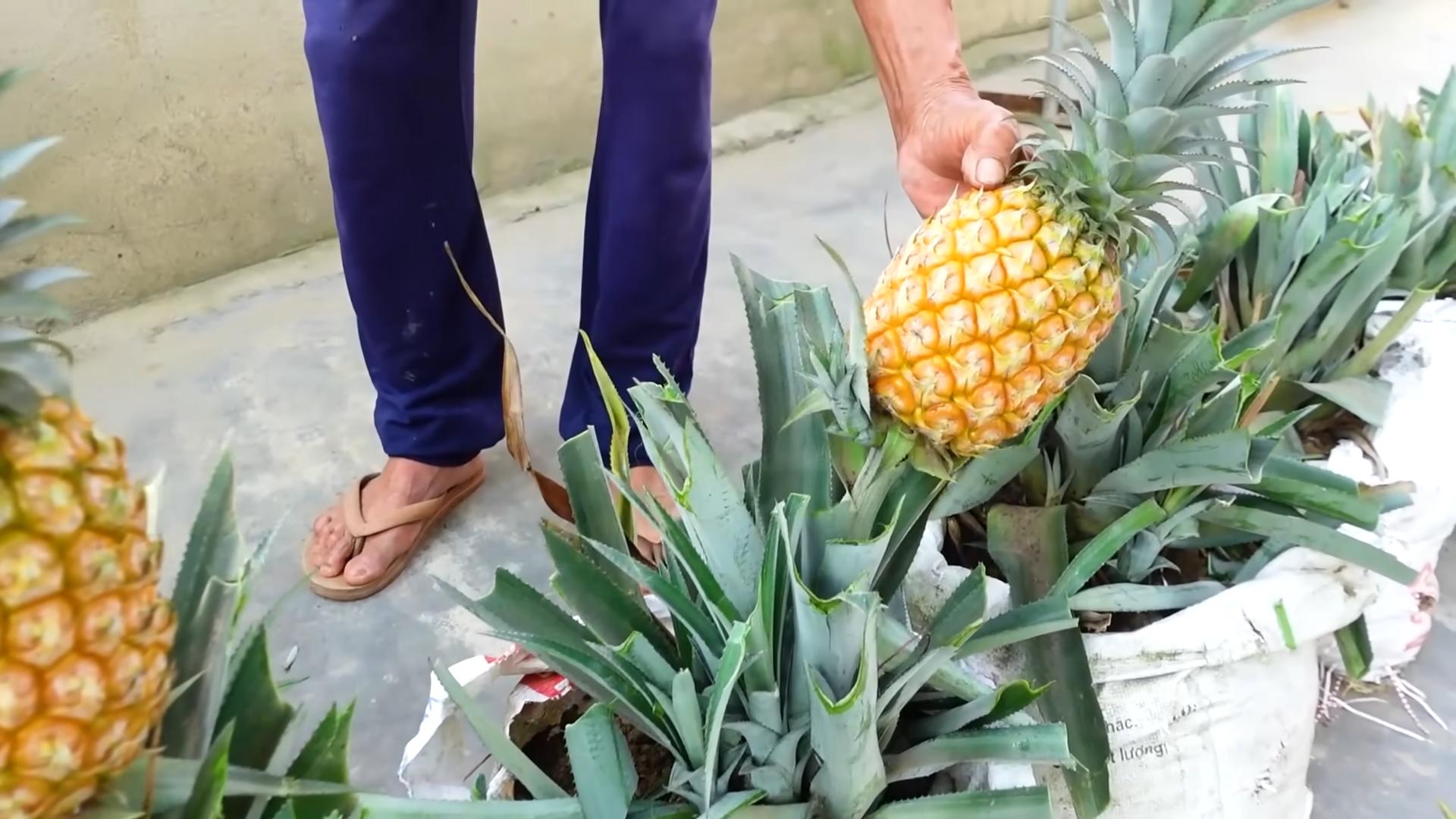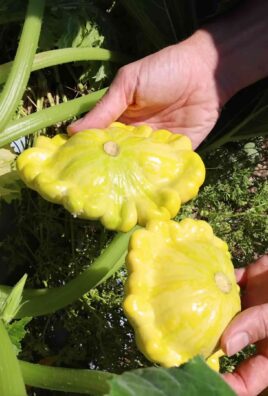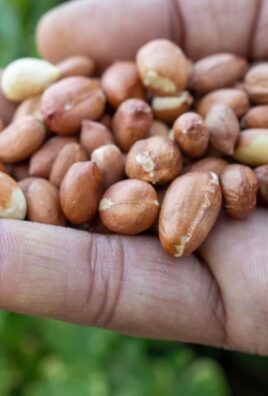Grow giant pineapples at home? Absolutely! Imagine the look on your neighbor’s faces when they see you harvesting a massive, juicy pineapple right from your own backyard. It sounds like a tropical dream, doesn’t it? Well, it’s more attainable than you might think, and this DIY guide is going to show you exactly how to make it happen.
Pineapples, originally native to South America, have a rich history, traveling across continents and becoming a symbol of hospitality and luxury. In colonial times, displaying a pineapple was a sign of wealth and welcome. Now, you can bring that touch of tropical elegance to your own home, and on a grand scale!
Let’s be honest, store-bought pineapples are often expensive and sometimes lack that intense, fresh flavor. Plus, there’s something incredibly satisfying about growing your own food. This DIY trick isn’t just about saving money; it’s about connecting with nature, learning new skills, and enjoying the unparalleled taste of a homegrown, giant pineapple. I’m excited to share these simple yet effective techniques that will help you grow giant pineapples at home, even if you don’t have a green thumb. Get ready to impress your friends and family with your amazing gardening skills!

Grow Giant Pineapples at Home: A DIY Guide
Hey there, fellow gardening enthusiasts! Ever dreamed of harvesting your own juicy, oversized pineapples right in your backyard? Well, dream no more! I’m going to walk you through a surprisingly simple DIY project that will have you enjoying homegrown, giant pineapples in no time. It takes patience, but trust me, the reward is well worth the wait.
Choosing Your Pineapple Top
The first step to pineapple paradise is selecting the right starting material. You won’t be planting seeds; instead, we’ll be using the top of a store-bought pineapple.
* Look for a healthy pineapple: Choose a pineapple that’s ripe, but not overripe. The leaves should be a vibrant green, free from brown spots or signs of disease. The fruit itself should be fragrant and slightly soft to the touch.
* Check the leaves: Make sure the leaves are firmly attached and not easily pulled out. Avoid pineapples with damaged or broken leaves.
* Consider the variety: Different pineapple varieties will produce different sized fruits. While you might not know the exact variety of your store-bought pineapple, generally, larger pineapples tend to produce larger tops.
Preparing the Pineapple Top for Planting
Now that you’ve got your pineapple, it’s time to prepare the top for planting. This is a crucial step to ensure successful rooting.
1. Twist or cut off the top: Firmly grasp the leaves of the pineapple top and twist it off the fruit. If it’s too difficult to twist, use a sharp knife to carefully cut the top off, leaving about an inch of fruit attached.
2. Remove the excess fruit: Carefully remove any remaining fruit from the base of the top. This is important because the fruit will rot and can attract pests or diseases. You can use a knife to gently scrape away the fruit, being careful not to damage the base of the leaves.
3. Peel back the lower leaves: Peel back several layers of the lower leaves until you expose about an inch or two of the stem. This will encourage root growth. Don’t be afraid to be a little aggressive here, but avoid damaging the core of the stem.
4. Let it callous over: This is a very important step! Place the prepared pineapple top in a dry, well-ventilated area for 3-7 days. This allows the cut end to callous over, preventing rot when you plant it. I usually put mine on a paper towel on a windowsill.
Rooting Your Pineapple Top
There are two main methods for rooting your pineapple top: in water or directly in soil. I prefer rooting in water because you can see the roots develop, but both methods work.
Rooting in Water (My Preferred Method)
1. Find a suitable container: Choose a glass or jar that’s wide enough to support the pineapple top and deep enough to hold a few inches of water.
2. Add water: Fill the container with clean, fresh water.
3. Submerge the base: Place the pineapple top in the water, ensuring that only the base of the stem (where you peeled back the leaves) is submerged. The leaves should remain above the water.
4. Find a sunny spot: Place the container in a warm, sunny location. A windowsill is ideal.
5. Change the water regularly: Change the water every 2-3 days to prevent algae growth and keep the water fresh.
6. Wait for roots to develop: Be patient! It can take several weeks (usually 2-8 weeks) for roots to develop. You should see small, white roots emerging from the base of the stem.
7. Plant when roots are established: Once the roots are a few inches long, your pineapple top is ready to be planted in soil.
Rooting Directly in Soil
1. Choose a pot: Select a pot that’s at least 6 inches in diameter and has drainage holes.
2. Prepare the soil: Use a well-draining potting mix. A mix of equal parts potting soil, perlite, and sand works well.
3. Plant the pineapple top: Make a hole in the center of the soil and plant the pineapple top, burying the base of the stem (where you peeled back the leaves) about an inch deep.
4. Water thoroughly: Water the soil thoroughly after planting.
5. Find a sunny spot: Place the pot in a warm, sunny location.
6. Keep the soil moist: Keep the soil consistently moist, but not soggy.
7. Wait for roots to develop: It can take several weeks for roots to develop. You can gently tug on the pineapple top to check for resistance, which indicates that roots have formed.
Planting Your Rooted Pineapple Top
Whether you rooted your pineapple top in water or directly in soil, the next step is planting it in a larger pot or in the ground (if you live in a warm climate).
1. Choose a pot or location: If you’re growing your pineapple in a pot, choose a large pot (at least 12 inches in diameter) with drainage holes. If you’re planting it in the ground, choose a sunny location with well-draining soil. Pineapples thrive in warm climates (USDA zones 9-11).
2. Prepare the soil: If you’re planting in a pot, use a well-draining potting mix. If you’re planting in the ground, amend the soil with compost or other organic matter to improve drainage and fertility.
3. Plant the pineapple: Dig a hole that’s slightly larger than the root ball of your pineapple top. Carefully remove the pineapple from its container and place it in the hole. Backfill with soil and gently firm it around the base of the plant.
4. Water thoroughly: Water the soil thoroughly after planting.
Caring for Your Pineapple Plant
Now that your pineapple plant is planted, it’s time to provide it with the care it needs to thrive and produce a giant pineapple.
* Sunlight: Pineapples need at least 6 hours of direct sunlight per day.
* Watering: Water your pineapple plant regularly, especially during hot, dry weather. Allow the soil to dry out slightly between waterings. Avoid overwatering, which can lead to root rot.
* Fertilizing: Fertilize your pineapple plant every 2-3 months with a balanced fertilizer. Look for a fertilizer that’s specifically formulated for tropical plants. I like to use a slow-release fertilizer.
* Temperature: Pineapples thrive in warm temperatures (between 65°F and 85°F). Protect your plant from frost and freezing temperatures. If you live in a colder climate, you can bring your potted pineapple plant indoors during the winter.
* Pest control: Keep an eye out for pests such as mealybugs and scale. If you notice any pests, treat them with an insecticidal soap or neem oil.
* Mulching: Apply a layer of mulch around the base of the plant to help retain moisture and suppress weeds.
Encouraging Fruiting
Pineapples typically take 1-3 years to produce fruit. Here are a few tips to encourage fruiting:
* Ethylene gas: Pineapples are sensitive to ethylene gas, which can trigger flowering. You can expose your pineapple plant to ethylene gas by placing a ripe apple or banana near the plant for a few days. Cover the plant and fruit with a plastic bag to trap the gas.
* Magnesium sulfate (Epsom salts): Epsom salts can help promote flowering and fruit production. Dissolve 1 tablespoon of Epsom salts in 1 gallon of water and apply it to the soil around the plant every few months.
* Patience: Sometimes, all it takes is patience. Just keep providing your pineapple plant with the care it needs, and eventually, it will reward you with a delicious fruit.
Harvesting Your Giant Pineapple
Once your pineapple fruit has developed, it’s time to harvest it.
* Check for ripeness: A ripe pineapple will have a fragrant aroma and will be slightly soft to the touch. The color of the fruit will also change from green to yellow or golden.
* Harvest the pineapple: Use a sharp knife to cut the pineapple from the plant. Leave a few inches of stem attached to the fruit.
* Enjoy your harvest: Now it’s time to enjoy the fruits (literally!) of your labor. Cut up your giant pineapple and savor its sweet, juicy flavor.
Troubleshooting
* Yellowing leaves: Yellowing leaves can be a sign of overwatering, underwatering, or nutrient deficiency. Adjust your watering schedule and fertilize your plant if necessary.
* Brown spots on leaves: Brown spots on leaves can be a sign of fungal disease. Treat the plant with a fungicide.
* No fruit: If your pineapple plant isn’t producing fruit, try exposing it to ethylene gas or applying Epsom salts. Be patient

Conclusion
So, there you have it! Cultivating your own giant pineapples at home isn’t just a gardening project; it’s an adventure, a testament to patience, and a rewarding experience that culminates in a delicious, homegrown treat. We’ve walked you through the process, from selecting the perfect pineapple top to nurturing your plant and coaxing it into producing those impressive, oversized fruits.
Why is this DIY trick a must-try? Because it connects you to your food in a profound way. It allows you to witness the miracle of growth firsthand, appreciate the effort that goes into producing the food we often take for granted, and ultimately, savor a pineapple that tastes all the sweeter because you nurtured it from start to finish. Forget the store-bought varieties, often picked before they’re truly ripe and shipped across vast distances. Imagine the unparalleled flavor of a sun-ripened, juicy giant pineapple, grown right in your own backyard or even in a large container on your patio.
But the benefits extend beyond just taste. Growing your own pineapple is also an environmentally conscious choice. You’re reducing your carbon footprint by eliminating the need for transportation and supporting sustainable practices. Plus, it’s a fantastic conversation starter and a unique way to impress your friends and family.
Don’t be afraid to experiment with variations! While we’ve focused on the traditional method, consider exploring different soil mixes to optimize growth. Some gardeners swear by adding specific nutrients or using particular types of compost. You could also try different pineapple varieties to see which one thrives best in your climate and produces the most impressive giant pineapple. Perhaps you’ll discover a new favorite!
Remember, patience is key. Growing a giant pineapple takes time and dedication. There will be moments of doubt, perhaps even setbacks. But don’t give up! The reward of harvesting your own homegrown pineapple is well worth the wait.
We wholeheartedly encourage you to give this DIY trick a try. It’s a fun, educational, and ultimately delicious project that will bring joy and satisfaction to your life. And once you’ve successfully grown your own giant pineapple, we want to hear all about it! Share your experiences, your tips, and your photos with us. Let’s create a community of pineapple enthusiasts, sharing our knowledge and celebrating our successes.
So, grab a pineapple, get your hands dirty, and embark on this exciting gardening adventure. You might just surprise yourself with what you can achieve. Happy growing!
Frequently Asked Questions (FAQ)
1. How long does it really take to grow a giant pineapple?
Growing a giant pineapple from a top is a long-term commitment, typically taking anywhere from 2 to 3 years, sometimes even longer. Several factors influence the growth rate, including climate, sunlight exposure, soil quality, and the specific pineapple variety. While it requires patience, the reward of harvesting your own homegrown pineapple is well worth the wait. Don’t be discouraged if it takes longer than expected; just continue to provide the plant with the care it needs, and you’ll eventually be rewarded with a delicious fruit.
2. What kind of climate is best for growing pineapples?
Pineapples thrive in warm, tropical or subtropical climates. They prefer temperatures between 65°F and 95°F (18°C and 35°C). They are sensitive to frost and prolonged periods of cold weather. If you live in a cooler climate, you can still grow pineapples in containers and bring them indoors during the winter months. Ensure they receive plenty of sunlight, even indoors, by placing them near a sunny window or using grow lights.
3. What type of soil is ideal for growing giant pineapples?
Pineapples need well-draining soil that is slightly acidic. A sandy loam soil is ideal. You can create a suitable soil mix by combining equal parts of potting soil, sand, and perlite. This will provide good drainage and aeration, which are essential for healthy root growth. Avoid heavy clay soils, as they can retain too much moisture and lead to root rot.
4. How much sunlight do pineapples need?
Pineapples require at least 6 hours of direct sunlight per day. The more sunlight they receive, the better they will grow and the more likely they are to produce fruit. If you are growing pineapples indoors, place them near a south-facing window or use grow lights to supplement natural sunlight.
5. How often should I water my pineapple plant?
Water your pineapple plant regularly, especially during the growing season (spring and summer). Allow the soil to dry out slightly between waterings. Avoid overwatering, as this can lead to root rot. In the winter months, reduce watering frequency. A good rule of thumb is to water deeply when the top inch of soil feels dry to the touch.
6. Do I need to fertilize my pineapple plant?
Yes, fertilizing your pineapple plant is important for healthy growth and fruit production. Use a balanced fertilizer (e.g., 10-10-10) every 2-3 months during the growing season. You can also use a liquid fertilizer diluted to half strength every 2 weeks. Avoid over-fertilizing, as this can damage the plant.
7. How do I encourage my pineapple plant to fruit?
Getting a pineapple plant to fruit can sometimes be tricky. One common trick is to expose the plant to ethylene gas. You can do this by placing a ripe apple or banana near the plant and covering it with a plastic bag for a few days. The ethylene gas released by the fruit will stimulate flowering. You can also purchase ethylene-releasing products specifically designed for this purpose. Ensure the plant is mature enough (at least 2-3 years old) and has received adequate sunlight and nutrients before attempting to induce flowering.
8. What are some common pests and diseases that affect pineapple plants?
Pineapple plants can be susceptible to pests such as mealybugs, scale, and spider mites. Inspect your plant regularly for signs of infestation and treat accordingly with insecticidal soap or neem oil. Root rot is a common disease that can affect pineapples, especially if they are overwatered. Ensure good drainage and avoid overwatering to prevent root rot.
9. Can I grow a giant pineapple indoors?
Yes, you can grow a giant pineapple indoors, but it requires providing the plant with the right conditions. Ensure it receives plenty of sunlight, either from a sunny window or grow lights. Use a well-draining potting mix and water regularly, allowing the soil to dry out slightly between waterings. Fertilize every 2-3 months during the growing season. Choose a large container to accommodate the plant’s growth. While indoor-grown pineapples may not reach the same size as those grown outdoors, you can still enjoy the satisfaction of growing your own fruit.
10. How do I know when my pineapple is ripe?
Determining when a pineapple is ripe can be tricky, but there are a few telltale signs. The pineapple should have a vibrant color, typically a golden yellow. The fruit should also have a sweet, fragrant aroma. Gently tug on one of the leaves near the top of the pineapple; if it comes out easily, the pineapple is likely ripe. The bottom of the pineapple should also feel slightly soft to the touch. Avoid pineapples that are green, hard, or have a sour smell.





Leave a Comment